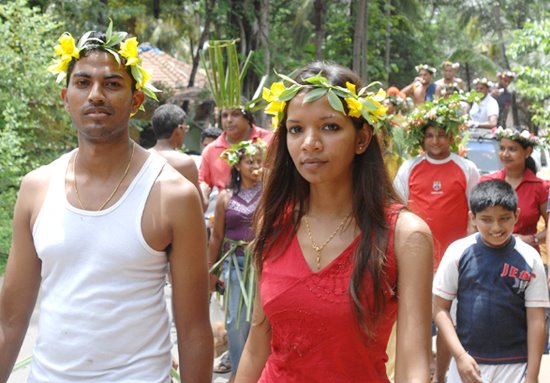
In Goa, the monsoon doesn’t just bring rain—it brings rhythm, rituals, and the jubilant celebration of Sanjão. Among the many beautiful traditions of this festival, the kopel holds a special place. Often misunderstood as a mere accessory, the kopel—a crown or headband made of wildflowers and leaves—carries deep cultural and symbolic significance, especially for women and young girls.
What is a Kopel?
A kopel is a handcrafted floral crown typically made using wild blooms, ferns, mango leaves, hibiscus, and fragrant herbs gathered fresh from the surroundings. Women weave them into stunning headpieces, often adding fruits or berries for embellishment. These are worn during the festival, especially while participating in singing, dancing, and the traditional vhodde (water games).
Significance of Kopel in Sanjão
- Symbol of Fertility and Nature
Sanjão is celebrated in honour of St. John the Baptist, who is known for his connection to nature and purity. The kopel, made with elements from the earth, becomes a tribute to nature’s bounty and the monsoon’s role in rejuvenating life. Wearing one symbolizes a blessing for fertility, growth, and abundance. - Expression of Devotion and Joy
The act of making a kopel is often meditative. Women gather in groups, sharing laughter, stories, and songs as they weave these crowns. This process becomes an expression of community, devotion, and gratitude for a good harvest and the blessings of water. - Cultural Identity and Aesthetics
In Goan villages, every kopel is unique, reflecting regional flora and local creativity. For young girls, wearing a flower crown is not just a festive act—it’s a moment of cultural pride, connecting them to their roots. - Connection to Eco-Conscious Traditions
Long before sustainability was a trend, the kopel stood as a testament to eco-friendly celebration. No plastics, no synthetic materials—just biodegradable beauty from the wild. It’s a gentle reminder that celebrations can be both joyful and kind to nature.
The Revival of a Beautiful Custom
In recent years, as Goans seek to preserve their rich cultural heritage, the kopel tradition is being joyfully revived in urban homes and modern Sanjão parties too. Instagram is now full of vibrant photos of women proudly wearing their floral crowns, bringing the age-old charm of the Flower crown into contemporary celebration.
In Conclusion
More than just a crown of flowers, the kopel is a symbol of reverence. For nature, for tradition, and for the divine spirit of Sanjão. As you join the celebrations, take a moment to weave your own kopel, not just with flowers, but with love, gratitude, and a deep connection to the land and its blessings.


